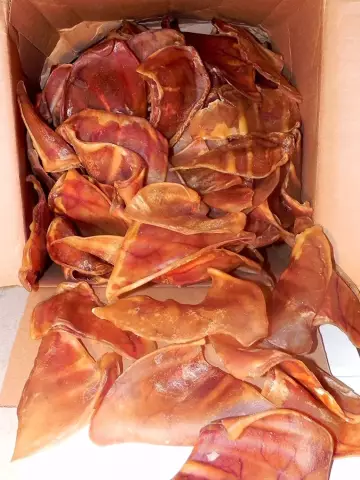- Author Rachel Wainwright [email protected].
- Public 2023-12-15 07:39.
- Last modified 2025-11-02 20:14.
Pork shank
Most people love pork knuckle, and there is absolutely nothing strange about this. Tender and juicy meat is used in many cuisines of the world for preparing a wide variety of dishes. Among the most interesting dishes on how to cook pork knuckle are Czech Veprevo koleno, English Pig's knuckle and, of course, German Schweine Haxe and Eisbein.

Shank (or pork shank) is the part of a pork leg adjacent to the knee joint. It consists mainly of rough muscles and connective tissues. When cutting pork, the boundaries of the separation of the semi-finished product are the knee and elbow joints, as well as the line of separation of the leg. The hind shank is considered more fleshy, so it is most common.
How to cook pork shank?
There is enough meat on the shank to prepare not only soups, but also main courses from it. It is known, for example, such a dish as smoked shank, which rightfully takes pride of place in the preparation of rich pea soup. The fresh part of the ham can be deliciously baked in the oven, having previously boiled until tender. In some recipes, before boiling and baking, it is recommended to marinate the knuckle in a mixture of wine or wine vinegar with water, with the addition of spices and salt.
A very popular dish is pork shank roll, which tastes like boiled pork, only much juicier and softer. You can also cook boiled-smoked shank, which, although it cannot be attributed to too healthy dishes, but on holidays it is quite possible to pamper yourself with this tasty, juicy and aromatic product, supplementing it with a glass of high-quality light beer and all kinds of pickles.
Why you shouldn't use shank regularly? Because it is a high-calorie food with high nutritional value. The most suitable side dish for the shank is stewed, sour or fresh cabbage.

Composition and calorie content of pork shank
100 g of pork shank contains 53.9 g of water, 0.8 g of ash; vitamins: biotin (H), tocopherol (E), cobalamin (B12), folic acid (B9), pyridoxine (B6), pantothenic acid (B5), riboflavin (B2), thiamine (B1), niacin (PP); minerals: tin, nickel, cobalt, molybdenum, manganese, chromium, copper, fluorine, iodine, sulfur, iron, phosphorus, chlorine, potassium, calcium, magnesium, sodium.
The calorie content of a pork shank is approximately 335 kcal per 100 g of product. A standard carcass weighs about 1.2 kg, so cooking one piece is quite enough for a full and hearty dinner for at least two people. It should be noted that during the cooking process, the shank decreases significantly in size.
YouTube video related to the article:
Found a mistake in the text? Select it and press Ctrl + Enter.






